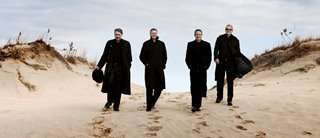|
Back
A Quintet of Quintets New York
Stern Auditorium, Carnegie Hall
05/07/2017 -
Maurice Ravel: String Quartet in F major
Alban Berg: String Quartet, Op. 3
Johannes Brahms: Quintet for Piano and String Quartet in F minor, Op. 34
Marc-André Hamelin (piano), Emerson String Quartet: Eugene Drucker, Philip Setzer (violins), Lawrence Dutton (viola), Paul Watkins (cello)

The Emerson Quartet (© Lisa-Marie Mazzucco)
“I learned this book from my students...”
Arnold Schoenberg, first line of his forward to Harmonielehre (Theory of Harmony) 1911
Alban Berg accomplished the difficult transition from student of Schoenberg to colleague of the great composer in 1911 with the completion of his third work, the String Quartet. The very tall Berg and the diminutive Anton Webern became the star acolytes of the master, even leading the parades of his followers – both literally and figuratively – through the streets and back alleys of the über-fertile environment of pre-war Vienna. A visit today to the Arnold Schoenberg Institute there and a short walk to the concert halls nearby lulls one into thinking that he is back in time to that exciting era of exploration, what Schoenberg evokes in his second string quartet as “the air of a new planet”. The newest iteration of the Emerson String Quartet presented Berg’s work after intoning the third version heard by this listener in just over two months of the Ravel piece in the same genre.
A disappointingly small crowd came to hear this concert and one could not help but think that the inclusion of the Berg may have been the reason for so many empty seats. The Schoenberg school has remained anathema through the years, although those of us who have taken a deep dive into this music are hard pressed to understand why. Cavernous Carnegie Hall can accommodate a chamber concert without any artificial acoustical aids – when the New York Philharmonic presents their players in chamber music at David Geffen Hall they must put up a huge screen at their rear to keep the small sound vital to the audience – and so the body of sound of the quartet was not only audible but immediate throughout this remarkable venue.
Comparing this iteration with the recently experienced Takács and Escher versions whispered that there was in fact no comparison, as the Emerson captured the fragile music of the Ravel like they were cradling a baby bird. There necromancers produced a sound that was spectral in sections, kittenish in others. A true feast for the ear, produced by masters. Their sensitive blending simply stunned this listener, who had thought that the two other versions recently experienced were quite good until he heard these amazing players!
Switching gears, the Emerson morphed into a much more steadfast sound for the Berg. This was a solid performance, but perhaps just a bit off center in emotional content. The group emphasized the thickness of the work, sounding, at least to these ears, like a reminiscence of the master’s “Vergangenes” from his Five Pieces for Orchestra, written just the year before in 1909. For these first two works, Mr. Setzer was in the first violin chair.
The best example of the thickness of the chamber music of Brahms is the Quintet for Piano and String Quartet. In fact, the adaptation by the composer for two pianos (Op. 34b) scans just like a symphony and a chockablock one at that. The Emerson had originally scheduled the enigmatic Maurizio Pollini as their pianist, but after he cancelled they chose the powerful and rock-steady keyboardist Yefim Bronfman to anchor this performance. After he cancelled, Marc-André Hamelin took over.
So this group, only assembled three days ago, had their work cut out for them. Perhaps the most important member of the team was the page turner, as Mr. Hamelin had his eyes glued to the score throughout the performance. He provided a steady undercurrent but was nowhere near as forceful as Mr. Bronfman would have been and who knows what Signor Pollini might have brought to the party. With Mr. Drucker now in the first chair and this critic ensconced in the very back row of the hall (quite a long distance from the stage) the group continued to dazzle with a spirited and robust performance. Their Allegro non troppo was quite martial, their Scherzo masterfully blended and designed for maximum emotional impact, their surprise coda, false ending and remarkably exciting actual finish quite thrilling. Although we still have the MET Orchestra under Salonen in our immediate future, my vote for concert of the year goes to these superb musicians.
This concert is the first in a series of five events over the next month featuring instrumental quintets. It should be an interesting, challenging and rewarding experience.
Fred Kirshnit
|